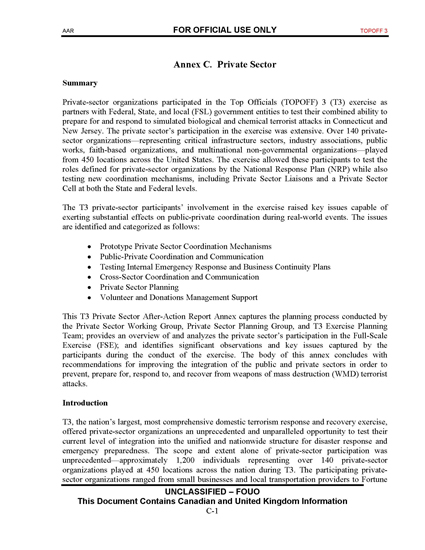TOPOFF 3 After Action Report
- 22 pages
- For Official Use Only
- This document contains Canadian and United Kingdom information
- November 15, 2005
Summary
Private-sector organizations participated in the Top Officials (TOPOFF) 3 (T3) exercise as partners with Federal, State, and local (FSL) government entities to test their combined ability to prepare for and respond to simulated biological and chemical terrorist attacks in Connecticut and New Jersey. The private sector’s participation in the exercise was extensive. Over 140 private sector organizations—representing critical infrastructure sectors, industry associations, public works, faith-based organizations, and multinational non-governmental organizations—played from 450 locations across the United States. The exercise allowed these participants to test the roles defined for private-sector organizations by the National Response Plan (NRP) while also testing new coordination mechanisms, including Private Sector Liaisons and a Private Sector Cell at both the State and Federal levels.
The T3 private-sector participants’ involvement in the exercise raised key issues capable of exerting substantial effects on public-private coordination during real-world events. The issues are identified and categorized as follows:
• Prototype Private Sector Coordination Mechanisms
• Public-Private Coordination and Communication
• Testing Internal Emergency Response and Business Continuity Plans
• Cross-Sector Coordination and Communication
• Private Sector Planning
• Volunteer and Donations Management SupportThis T3 Private Sector After-Action Report Annex captures the planning process conducted by the Private Sector Working Group, Private Sector Planning Group, and T3 Exercise Planning Team; provides an overview of and analyzes the private sector’s participation in the Full-Scale Exercise (FSE); and identifies significant observations and key issues captured by the participants during the conduct of the exercise. The body of this annex concludes with recommendations for improving the integration of the public and private sectors in order to prevent, prepare for, respond to, and recover from weapons of mass destruction (WMD) terrorist attacks.
…
Purpose of the Private Sector Annex
The Private Sector Annex fulfills the fourth overarching objective for T3: “Evaluation: To identify lessons learned and promote best practices.” The description and analysis in this annex are intended to provide a basis for more robust and realistic private-sector play in future TOPOFF exercises. More importantly, the intent is to identify lessons learned that may be used by Federal, State, Local, and Tribal (FSLT) government and private-sector organizations alike to improve their real-world, day-to-day integration into FSLT emergency preparedness and disaster response. The overall goal is to improve the nation’s ability to mount an effective, integrated public-private response to and recovery from a WMD terrorist attack.
A second purpose of this annex is to facilitate the Federal government’s mandate for a meaningful critique of T3 private-sector integration, a critique that may be appropriately shared with the private sector. The NRP’s Private Sector Coordination Support Annex states that the Federal government “conducts after-action critiques of the procedures detailed in this annex with private-sector participants when they are exercised in national-level, DHS-sponsored exercises” and “shares such critiques appropriately with private-sector participants.” T3 was a nationallevel, DHS-sponsored exercise which tested procedures defined in the NRP’s Private Sector Coordination Support Annex. This Private Sector After-Action Report Annex is intended to serve as the basis for an appropriate T3 critique that will be shared with the private sector.
…
But T3 also demonstrated that real-world integration of the private sector into FSL government disaster response and recovery efforts is still in or near its infancy. Official government sources provided private-sector participants little of the information they needed to make sound, informed decisions. Private-sector participants perceived themselves to have been omitted from the decision-making processes on critical issues affecting their interests, as well as their ability to respond to the attacks. Private-sector participants deemed the lack of communication and coordination with official government sources to be particularly inadequate regarding travel restrictions, threat advisory level changes, and the availability and priority of necessary prophylaxis measures. Little or no advance private-sector coordination was provided before these decisions were announced. Once made, these decisions’ specific objectives and recommended responses were not effectively communicated to the private sector. As a result, private-sector participants were left to rely on their own sources of information (often that meant only VNN) and their own criteria for deciding how to protect their employees, keep critical employees on the job, and continue to provide services and resources essential to effective public-private response operations. Also, despite private-sector representatives’ efforts to provide effective responses to governmental RFIs, FSL government entities reported that the roles, responsibilities, and resources that private-sector organizations offer in a disaster response operation remain unclear.

